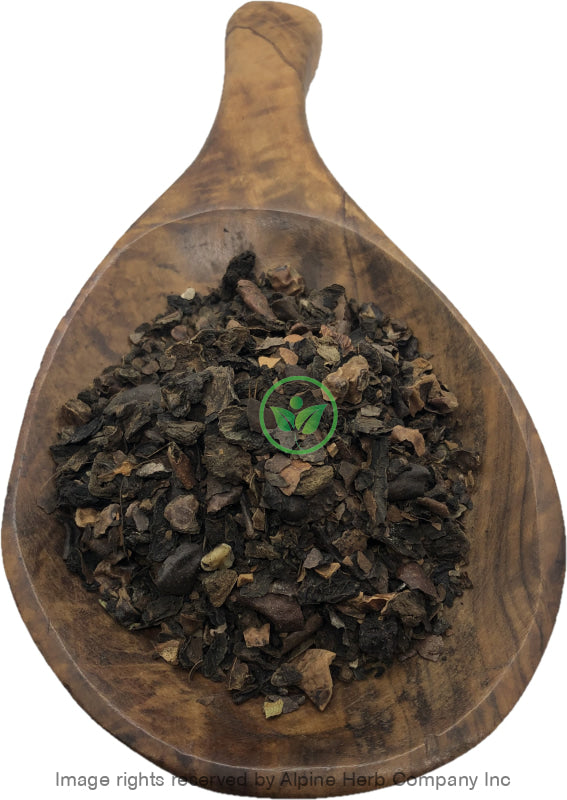Black Walnut Hull Cut Alpine Herb Company Inc.
$ 9,99 $ 5,99
Botanical Name: Juglans nigra
Common Name:
- English: Black Walnut Hull
- Also, known as: Carya, Walnoot, Jupiter’s nuts
Habitat: North America
Origin: Albania
Harvested: Cultivated
Parts Used: Hull
General Information:
Juglans nigra, the eastern black walnut, is a species of deciduous tree in the walnut family. A large tree that may grow to 120 feet, 6 – 12-inch lance-shaped leaves. Black Walnut Hull or Juglans Nigra is, just as it sounds, the hull of the black walnut tree. The Black Walnut tree grows in the eastern US and parts of Canada, and while easy to grow and it is a beautiful shade tree. Black Walnut has been used in herbal medicine for thousands of years.
The leaves are compound and alternately arranged on the stem. They are 25-50 cm long, typically even-pinnate but there is heavy variation among the leaves. The stems have 15–20 leaflets, with the largest leaflets located in the center, 8–10 cm long and 2–3 cm broad. The leaflets have a rounded base and a long pointed (acuminate) tip as well as having a serrated edge. The leaves are overall dark green in color and are typically hairy on the underside.
Fruit Ripens during the autumn into a fruit (nut) with a brownish-green, semi fleshy husk, and a brown, corrugated nut. The whole fruit, including the husk, falls in October or November; the seed is relatively small and very hard.
The immature fruits are round, green orbs with fleshy green outer husks that dry into very hard dark-brown nuts.
Because of its dark color, the outer hull is also used as a dye and was used in brown hair dye until the early 1900s.
Most parts of the tree, including leaves, stems, and fruit husks have a very characteristic pungent or spicy odor. This odor is lacking in the nut itself.
How to use:
Hot Infusion:
The basic method for dried herbs and flower is, take 2-3 tablespoons of dried herb in a cup or teapot. Pour hot water over it and cover it with lid for 10-30 minutes. Hot water is needed to draw out the antioxidants, enzymes, vitamins, flavonoids and volatile oils from the botanicals. Strain and squeeze out as much as liquid as possible and enjoy!
Tips:
- You can sweeten your herbal tea with a bit of honey, natural fruit juice, stevia leaves powder and or licorice root powder.
- You can make ice cubes or pops by freezing tea in ice trays or pop molds.
Precautions:
You should consult with a qualified healthcare practitioner before using any herbal products, particularly if you are pregnant, nursing, or on any medications.
All information on this website is for educational purpose ONLY
This information has not been evaluated by Health Canada.
This information is not intended to diagnose, treat, cure, or prevent any disease.
| Unit Size | 100g, 200g, 400g, 1kg |
|---|
Prompt shipping and expert packing
Thanks to our longstanding association with UPS FedEx DHL as well as other leading global carriers, we can offer a variety shipping options. Our warehouse staff is highly trained and will be able to pack your goods in accordance with our precise and exact specifications. Your items will go through an exhaustive examination before they will be securely packaged before being delivered. We ship to hundreds of thousands of customers daily in different countries. This is a sign of our determination to become the largest online retailer worldwide. Warehouses and distribution centers are located throughout Europe as well as in the USA.
Note that orders containing multiple items are processed according to the particular item.
We will thoroughly inspect all items ordered before shipping. Most orders are shipped within 48 hours. The delivery time will be between 3 and 7 working days.
Returns
The stock market is always changing. It's not entirely managed by us since we're involved with several entities, including the factory and the storage. Therefore, the actual inventory could fluctuate at any moment. Please be aware that it is possible that your order could be out of stock after you've placed your order.
Our policy lasts for 30 days. If it's been more than 30 days since the date you purchased your item We're sorry to say that we can't offer you a full exchange or refund.
You can only return a product if it is unused and still in the same state as when you received it. The item should be in the original packaging.


































